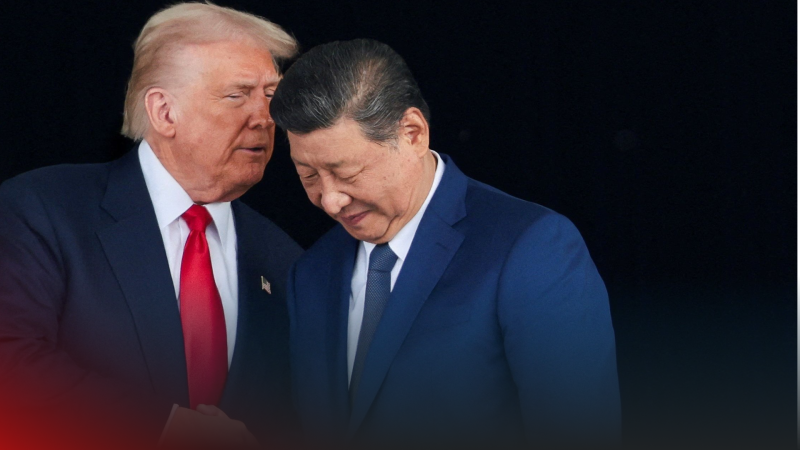Copyright Cable News Network

As the dust begins to clear around a less-than-two hour meeting between Chinese leader Xi Jinping and President Donald Trump at an airbase in South Korea on Thursday, it’s clear that China’s leaders have stacked up another win for their hardball strategy with the United States. The meeting did not secure a broad trade deal, but rather a return to an uneasy truce built on a handful of agreements meant to keep the relationship steady as the two sides move toward one. Xi walked away with a 10% reduction in 30% tariffs newly imposed by Trump on Chinese goods this year – in exchange for ramping up efforts to control its role in the US fentanyl crisis. He also secured US agreement to put on hold a new rule that would have vastly expanded the number of Chinese companies blacklisted from buying sensitive American tech. Trump averted Beijing imposing an expanded set of restrictions that could have hamstrung global industries reliant on China’s rare earths minerals. China will also ramp up purchases of US soybeans and other agricultural products, US officials said. Both sides also paused port fees targeting each other’s shipping sectors and will extend a truce on more elevated tariffs. On paper, it looks like a reasonable exchange – and one that delivers, at least for now, what both leaders (and the wider global economy) wanted: stability after a tumultuous year of sparring between the world’s economic heavyweights. But for Beijing, the agreements – which came with a side of effusive praise from Trump for Xi – are also a clear confirmation of the success of its strategy in how to handle Trump 2.0. That’s because Beijing has been able to win valuable concessions on tariffs and export controls, while primarily conceding measures they only put out as retaliation against those from the US in the first place. Take soybeans, a key American export that saw Chinese purchases plunge this year over trade frictions. China agreed to purchase a minimum of 25 million metric tons of American soybeans annually for the next three years, US agricultural secretary Brooke Rollins said after the talks. But that baseline is still 1.8 million metric tons less than that China’s soybean purchases last year, before the tensions, according to US data. China’s highly nationalistic and censor-curated internet clocked all this on Friday, when social media commenters praised how “China really nailed this tariff war,” and observed that “Trump finally dealt with the mess Trump created.” China’s game plan The outlook is not all rosy for China. Even as tariffs from this year’s US trade spat have been whittled down to 20%, Chinese exporters still face what on average amounts to nearly 50% duties on their goods, with pre-existing duties factored in. That rate remains among the highest imposed on any country by the US. Washington meanwhile has seen real progress on its goal to narrow their trade deficit. And, while the deal has yet to be inked, Beijing may have made some true concessions on the fate of the social media app TikTok, after changing its tune on staunch opposition to a US law requiring the app’s Chinese owner ByteDance to sell its US business. China also remains blocked from accessing the highest-end US chips, a key weapon in the high-stakes AI race playing out between the two countries. But on the tech front, Beijing’s ability to push back by at least a year the new US rule which would have vastly expanded the number of Chinese companies blacklisted from buying sensitive American technologies, is a major boon for Chinese firms. The now-suspended US effort to close loopholes could have ensnared some 20,000 more companies than are already on the list, according to an analysis by business intelligence firm WireScreen. That’s another win for Beijing’s strategy of using its near-total grip on the global rare earths supply chain as leverage against the US – a tactic it also deployed during a tariff escalation earlier this year. And on China’s side, agreeing to defer for at least a year its expanded export control regime on rare earth minerals, which it announced as retaliation for the US blacklist expansion, is unlikely to be seen as a major setback in Beijing. As one Chinese scholar, foreign policy analyst Shen Dingli, told CNN earlier this month, those measures were a “nuclear” option that Beijing knew wasn’t symmetrical – “but if China doesn’t use this weapon, China has little left to bargain with.” Whether Xi and Trump can manage to keep the detente as they work toward a broader deal and expected visits to each other’s countries in 2026 is the next big question. Canada, after all, knows first-hand that a trade truce struck with Trump can quickly collapse. A range of pitfalls, both foreseeable and unexpected, in the US and China’s expansive rivalry could derail the newly-reached stabilty – and whatever deal is ultimately reached is unlikely to address the deep-seated, structural issues between the two.



